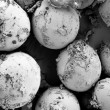Home > Press > Oral delivery of colon cancer drug
 |
Abstract:
Oral administration of anti-cancer agents is both more convenient and less painful than doing so intravenously. It can also afford controlled and sustained release, and reduce side-effects caused by the drug (or drugs). However, the environment which they have to pass through sets strict requirements for the materials used to transport them. Lingxue Kong and colleagues at Deakin University, Australia have now created a delivery vehicle for the cancer drug 5-fluorouracil (5-FU) that survives the harsh pH conditions en-route to the colorectal area.
Oral delivery of colon cancer drug
Germany | Posted on December 13th, 2012Dispensing drugs orally to this area of the body is particularly difficult because the delivery system has to survive the three different acidity levels of the stomach, duodenum and small intestine (pH 1.2, 4.5 and 6.8, respectively) before releasing at pH 7.4 in the colon and rectum. Reporting in the Journal of Applied Polymer Science, the authors describe a water-in-oil-in-water multiple emulsion and solvent evaporation technique to first load 5-FU into poly(lactic-co-glycolic acid) nanoparticles. The drug loading, encapsulation efficiency and particle size were optimised by varying the fabrication parameters, including adjusting the pH value of the outer water phase to the isoelectric point of 5-FU. The loaded nanoparticles are subsequently coated with the anionic polymer Eudragit S100 based on methacrylic acid and methyl methacrylate. Importantly this is insoluble in aqueous solutions of pH 7 or less.
In vitro drug dissolution tests mimicking both the time spent passing through and acidity of each part of the human gastrointestinal tract show no 5-FU release at pH 1.2 and 4.5, with very limited release at pH 6.8. At pH 7.4 there is an initial burst release followed by an extended slow release of up to 120 hours. The system clearly shows promise for treatment of colorectal cancer because it overcomes the often seen problems of both early drug release from nanoparticles and poor functionality of microspheres.
####
For more information, please click here
Copyright © Wiley-VCH Materials Science Journals
If you have a comment, please Contact us.Issuers of news releases, not 7th Wave, Inc. or Nanotechnology Now, are solely responsible for the accuracy of the content.
| Related Links |
![]() Link to the original paper on Wiley Online Library:
Link to the original paper on Wiley Online Library:
| Related News Press |
News and information
![]() Researchers develop molecular qubits that communicate at telecom frequencies October 3rd, 2025
Researchers develop molecular qubits that communicate at telecom frequencies October 3rd, 2025
![]() Next-generation quantum communication October 3rd, 2025
Next-generation quantum communication October 3rd, 2025
![]() "Nanoreactor" cage uses visible light for catalytic and ultra-selective cross-cycloadditions October 3rd, 2025
"Nanoreactor" cage uses visible light for catalytic and ultra-selective cross-cycloadditions October 3rd, 2025
Nanomedicine
![]() New molecular technology targets tumors and simultaneously silences two ‘undruggable’ cancer genes August 8th, 2025
New molecular technology targets tumors and simultaneously silences two ‘undruggable’ cancer genes August 8th, 2025
![]() New imaging approach transforms study of bacterial biofilms August 8th, 2025
New imaging approach transforms study of bacterial biofilms August 8th, 2025
![]() Cambridge chemists discover simple way to build bigger molecules – one carbon at a time June 6th, 2025
Cambridge chemists discover simple way to build bigger molecules – one carbon at a time June 6th, 2025
![]() Electrifying results shed light on graphene foam as a potential material for lab grown cartilage June 6th, 2025
Electrifying results shed light on graphene foam as a potential material for lab grown cartilage June 6th, 2025
Discoveries
![]() Researchers develop molecular qubits that communicate at telecom frequencies October 3rd, 2025
Researchers develop molecular qubits that communicate at telecom frequencies October 3rd, 2025
![]() Next-generation quantum communication October 3rd, 2025
Next-generation quantum communication October 3rd, 2025
![]() "Nanoreactor" cage uses visible light for catalytic and ultra-selective cross-cycloadditions October 3rd, 2025
"Nanoreactor" cage uses visible light for catalytic and ultra-selective cross-cycloadditions October 3rd, 2025
Announcements
![]() Rice membrane extracts lithium from brines with greater speed, less waste October 3rd, 2025
Rice membrane extracts lithium from brines with greater speed, less waste October 3rd, 2025
![]() Researchers develop molecular qubits that communicate at telecom frequencies October 3rd, 2025
Researchers develop molecular qubits that communicate at telecom frequencies October 3rd, 2025
![]() Next-generation quantum communication October 3rd, 2025
Next-generation quantum communication October 3rd, 2025
![]() "Nanoreactor" cage uses visible light for catalytic and ultra-selective cross-cycloadditions October 3rd, 2025
"Nanoreactor" cage uses visible light for catalytic and ultra-selective cross-cycloadditions October 3rd, 2025
|
|
||
|
|
||
| The latest news from around the world, FREE | ||
|
|
||
|
|
||
| Premium Products | ||
|
|
||
|
Only the news you want to read!
Learn More |
||
|
|
||
|
Full-service, expert consulting
Learn More |
||
|
|
||








